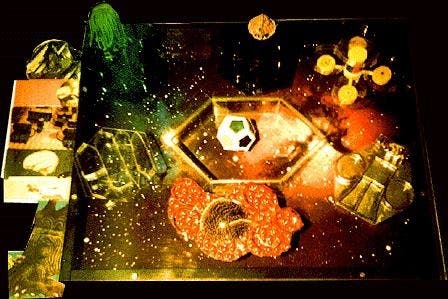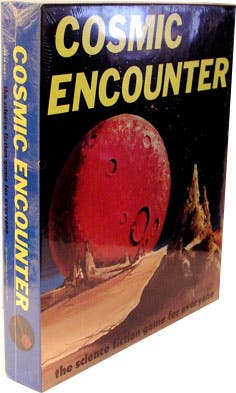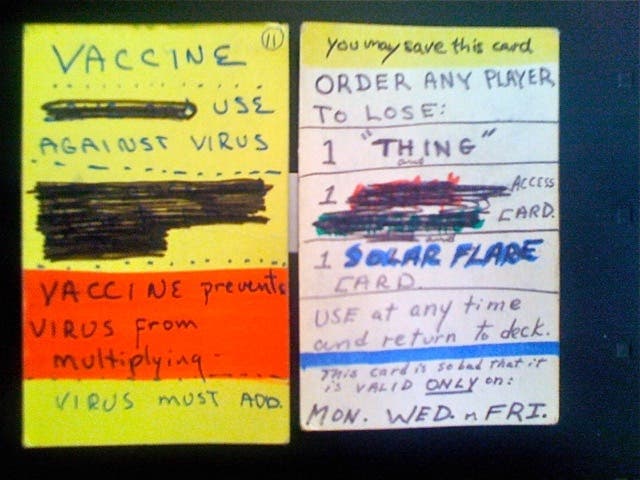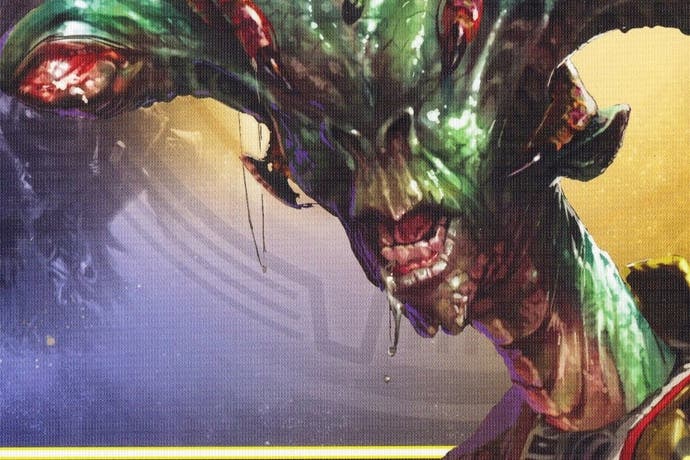The making of Cosmic Encounter, the greatest boardgame in the galaxy
Risk's legacy.
Midway through my conversation with the creators of Cosmic Encounter, the boardgame in which colourful aliens attempt to colonise each other's planets, Peter Olotka interrupts co-designer Bill Eberle to make a casual observation.
"By the way. There's no board," he says.
There's a brief silence as everyone, including Bill and Peter's son Greg, pauses to consider this, followed by a flutter of surprised laughter.
"Just to set the tone," Peter adds, as I try to steer the interview back on course for the third or fourth time.

You might think that the distinct lack of a board in a boardgame would be obvious to anyone who played it. It should be the first thing you notice upon opening the box, right? But if there's anything that encapsulates Cosmic Encounter's design better than that the fact it is a boardgame without a board, it's that this omission is likely to completely pass you by upon first playing it. It's something you only notice later on, once you've got past the half-dozen or so other ways that Cosmic Encounter tears through boardgame convention like a death-slinging heat-ray.
First published in 1977, Cosmic Encounter is a towering landmark in boardgaming history, regarded by many game critics as the finest example of the form. Boardgame savant Robert Florence voted it his favourite boardgame of all time, while tabletop gaming website Shut Up And Sit Down placed it first and second in their two most recent lists of the greatest boardgames ever created. In his review of the expansion, Cosmic Incursion, the Dice Tower's Tom Vassel referred to it as "probably the best game that's ever been made."
When I ask the creators about why they think Cosmic Encounter carries such a high-regard in boardgaming circles, their response is simply "We thought you were gonna tell us!" But behind the joke I detect a hint of frustration, and the longer we chat, the more this frustration comes to the fore.
As it turns out, this is not surprising. The story of Cosmic Encounter is about a flash of creative genius in the early seventies, followed by four decades of struggle to see that vision fully realised. Despite the rapturous critical acclaim Cosmic Encounter has accrued in the 39 years since its first publication, it has not been followed by commercial success. Indeed, the creators of the greatest boardgame in existence have never made a living off it.
Cosmic Encounter first landed on shelves in 1977, but its story begins half a decade earlier. Having worked in the Peace Corps on the Pacific Marshall Islands, Peter Olotka returned to Cape Cod in Massachusetts with his wife Cindy and young son Greg, and took a job as a Community Organiser for the Cape's anti-poverty program. He met Bill Eberle when he came for a job interview. Eberle had worked various jobs from being a teacher in Washington DC to a reporter in New Bedford. Olotka didn't hire Bill Eberle, but despite this the pair ended up becoming friends. He did hire another man, Jack Kittredge, and they became friends too. Along with a fourth friend, Bill Norton, who was working for the George McGovern Presidential Campaign, the group began meeting up regularly to play boardgames. But they soon became frustrated by the quality of the few games that were available.

"We had played a lot of Risk at the time, and when you play Risk, the end of the game is two people sitting there rolling dice for about three hours," Olotka says. "Everybody else who was playing was eliminated, and they're out in the kitchen making coffee and drinking wine. So we said 'Ok. We're not doing that, we're gonna have no dice in our game. As a rule' And we just started making up these kind of rules that were annoying us about playing Risk."
Over time, the list of rules for this unspecified game grew. It would be a game where more than one person could win. It would appeal to both men and women. It would be about Science Fiction. Then, in what Bill Eberle describes as an executive board meeting on a beach, this list of rules transformed into the idea that defines Cosmic Encounter. "Every time we played the game it would be different." Eberle says, "And you would play the game differently, instead of everybody being a general - boring! Or everybody being a landlord - boring!"
The basic skeleton of Cosmic Encounter has remained the same throughout its existence. It's an interstellar race in which players compete to colonise five alien planets through whatever means are available to them. Players take turns to have "Encounters" with other players, as determined by a "Destiny" card, drawn from the centre of the table. Both sides then deploy a number of ships into a portal, and can call for allies around the board to aid in attack and defence. Finally, they both play an encounter card. Unless they choose to negotiate an arrangement, each side adds the number of their encounter card to the number of deployed ships. Whoever has the highest number wins, and either gets to place a colony on one of the other player's planets, or successfully prevents this from happening.
Into this simple, vaguely Poker-ish game of galactic conflict are added the aliens. Before the game starts, each player chooses an alien to play as, and every alien gets to break a rule of the game. The Mind, one of the first six aliens the group created, can look at another player's hand of cards, while the Loser, can "upset" an encounter, meaning the winning side loses and the losing side wins. Olotka's preferred alien is the Philanthropist, which can give away cards to other players (including rubbish cards, enabling the Philanthropist to stack the other players' hands with bad cards and draw a new hand sooner than everyone else) while Eberle and Greg Olotka have a soft spot for the Sorcerer, which can switch the two cards played in an encounter, but without looking at them. "It's always getting hoisted by its own petard," Eberle laughs. "But what it does to the interaction between two players, when you know that the other player can or may not switch the two cards played, is just wonderful,"
The aliens embody Cosmic's core idea of playing differently every time. Including expansions, there are 165 alien races available for the game, with millions of potential rule-sets emerging out of those combinations. Back in the mid-seventies, in a boardgame market that pretty much consisted of Monopoly, Cluedo, Scrabble and a few other staples, there was absolutely nothing else like it.
"I would say that there was one game where it existed. Chess. The pieces were different," Olotka says. "To give Chess credit, it might be called the precursor to Cosmic."
In 1972, the four men formed the game design cooperative Future Pastimes, in a concerted effort to put this explosively original idea into production. But when it came to actually making and selling the game, Olotka and Eberle admit that they had no idea what they were doing. "We learned how to be game designers by designing Cosmic Encounter," Eberle says. This is evidenced by the game's early prototypes. These truly alien creations, which resemble something out of an HP Lovecraft story, were cobbled together out of whatever materials the group could get their hands on. Egg-cups, metal wires, Styrofoam, Tinker Toys. There was even a version made out of Plexiglass.
On top of that, Future Pastimes was attempting to market this bizarre-looking Science Fiction game to publishers at a time when "geek culture" was almost non-existent. To briefly illustrate, a little role-playing game known as Dungeons & Dragons was first published in 1974, two years after the formation of Future Pastimes. Regardless, Future Pastimes pitched Cosmic Encounter to Parker Brothers, perhaps the most eminent boardgame publisher in history, and Parker Brother's response was to immediately throw them out. "They said they'd have trouble manufacturing that," Greg Olotka says as he shows me the prototype photographs.

Shortly afterwards Parker Brothers got back to them, curiosity piqued. "They said they really wanted to know what this strange game was, so come back and teach us how to play it," Eberle says. So Future Pastimes did, and eventually Parker Brothers licensed the game. But the results weren't what Future Pastimes hoped for. "They created a terrible prototype. Out of all plastic. They didn't feature the aliens, or make the aliens interesting at all." At some point in 1977 Parker Brothers cancelled the project. Eberle recalls they received an advance of five thousand dollars and a message that "Space doesn't sell." "I think about three months later, Star Wars hit the big screen," he says.
Eberle and the others left Parker brothers disillusioned by the boardgame publishing industry, and decided to use their advance to manufacture and publish the game themselves. Bill Norton departed the cooperative around this time, and the others formed a new company, Eon Products, with a man named Ned Horn who offered to invest in Cosmic Encounter.
Later in 1977, the first version of Cosmic Encounter was published under Eon Products' homespun label. They did everything themselves, sourcing game components, even shrink-wrapping their own boxes. "We had a factory, you know, a warehouse that we rented with all these boxes, ten thousand boxes of Cosmic Encounter in it," Olotka says. They also realised that they could stretch the game much further than they previously thought. "We released the game with fifteen aliens, and the fans, once we got it out there, said 'we want more'. So I think we actually invented the idea of expansion sets."
Sadly, although Cosmic Encounter received a small and enthusiastic audience, the designers discovered that retailers were just as reluctant to take on a new game as the publishers. "You're trying to sell one game into a market that you can't sell one game into," Olotka says. "I mean, the Toy Scope people were big-time buyers of Monopoly. They're not going to buy anybody's one game. So it's practically impossible."

Eventually, realising that self-publishing wasn't viable, the group began looking for a third-party publisher again. In 1986 Cosmic was picked up by West End games, who licensed several foreign versions, including the British version published by Games Workshop. But they struggled to sell the game in the US and eventually gave up. The lowest moment for Cosmic Encounter came in 1991, when Mayfair games agreed to publish the game. "Mayfair stiffed us on the royalties. They just made the game and sold it without paying us," Olotka says. "We cancelled the contract because they weren't paying us, and they kept selling it until they had none left, and they never paid us."
Hope sprung again in 2000, shortly after Hasbro purchased Avalon-Hill games along with around 200 titles. Despite this huge acquisition, there was another game they wanted. "Mike Gray was a Cosmic fan and running the show for the Avalon-Hill thing. [He] called me and said "I wanna do Cosmic," Olotka says. Hasbro created a visually stunning version of Cosmic, including spaceships that were carried around in a larger, plastic Mothership. "And it was a total flop. Really, it was a total flop," Olotka says. His son Greg elucidates on why: "The board looked great, and the ships were very pretty-looking. But they had a lot of fundamental flaws, like you couldn't load the little ships into the Mothership."
For over 30 years Cosmic Encounter bounced around the boardgame publishing industry like a lost alien searching for its home planet. In its lifetime, the game has been published by six different companies, and, by Olotka's reckoning, has been declined by far more. "Cosmic Encounter has been rejected by every single game publisher on the planet. At least once, maybe more than once. I have files showing all of the people we tried to get to do this game. Nobody wanted it."
In 2008, 31 years after Cosmic Encounter was first released, the game finally found a publisher that Olotka and Eberle felt truly understood it - Fantasy Flight. They attribute a lot of Cosmic's more recent successes to Kevin Wilson, who is responsible for Cosmic's current look. This includes the "phase bar" at the bottom of the alien cards which tells players when their alien power comes into effect. "That little strip, which the first time I saw it I said to Kevin 'This is the worst thing you ever did to the game' - that's how smart I am. That has made this game work," Olotka says.
Fantasy Flight also understand the importance of expansions to Cosmic, having released five new expansions for it since 2010. The most recent of these, Cosmic Dominion, featured aliens that were designed by fans. "We convinced Fantasy Flight that the fans could actually do the work of the designers. And Fantasy Flight graciously said okay," Olotka says. Their faith was well judged, as it proved one of Cosmic's most popular expansions. There are more expansions in the works, which Olotka cryptically declares "goes beyond" the basic rules adhered to in previous expansions.

With Fantasy Flight at the helm, Cosmic has sold more copies than it has with any other publisher. Yet it's still a long way from rivalling the most lucrative boardgames like Carcassonne or Settlers of Catan. "We would have to sell twenty times more than it's selling now, for it to become, like a big selling product," Olotka says.
So why the disparity between Cosmic's critical reception and its commercial success? There are multiple possibilities the creators suggest. Eberle believes that the game is primarily popular among other game designers rather than hobbyist players, while Greg notes the theme has been mentioned as a potential sticking point, that perhaps it would be more popular if it had a fantasy setting rather than sci-fi. There's also the fact that Fantasy Flight tend to print in small batches which sell out quickly, making it difficult to get hold of from time to time.
In addition, Cosmic Encounter can be quite a polarising game amongst certain sectors of the boardgame community. Some gamers, particularly those who are keen on strategy and wargames, believe that Cosmic is unfair, that certain aliens or combinations will tip the balance in favour of a particular player. This is a criticism that the designers refute entirely. "Every power has an Achilles' Heel, no matter how strong it seems," says Greg Olotka, "People get really angry when their carefully crafted strategy falls apart because some other guy got lucky with a card. I've never really understood the complaints, because you could say that about almost any game. Every other game has cards that are random."
The numbers might still be lower than Eberle and the Olotkas would hope, but Cosmic Encounter's audience is expanding. The designers recently launched a new website that attempts to bring together everything Cosmic Encounter related - social media feeds, mentions on the BoardGameGeek forums, links to the Cosmic Encounter Connector, the digital version of Cosmic available for TableTop Simulator. Greg Olotka handles much of the social media side, and he has noticed a marked uptick in people talking about Cosmic in the last couple of years, especially amongst young people, which to him is a great relief. "They can't all be around our age or we'll run out of customers!"
Even if Cosmic Encounter never sees the kind of commercial success that might be expected given its standing within the boardgame community, the designers are still immensely proud of the game's impact and legacy. "Cosmic Encounter opened the designers' eyes as to how much could be done with a boardgame," Eberle concludes. "We said we wanted the game to feel like these experiences we had when we read Science Fiction, where the unexpected happens. You believe it, you get into it, and we wanted to create a game that would recapture some of that magic. And damned if we didn't."
"It was probably beginner's luck," he adds.

